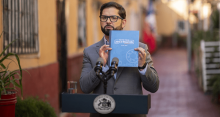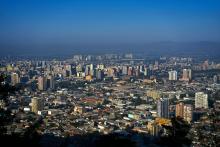
With innovations such as license plate readers in buses, contactless payment systems, vehicles and drivers using technology and artificial intelligence, among others, urban mobility is being transformed to offer safety, efficiency and a better quality of life for its inhabitants.
Chile, Brazil and Mexico are the countries where the most investment is made in technologies for the city, highlighting the city of Santiago as the most innovative in all of Latin America, according to Marco Alexandre Moniz, Regional Business Development Manager of SONDA, a Chilean IT company and integrator. of systems, during his presentation at the América Digital 2024 event, held this week in the Chilean capital.
Although it essentially depends on the regulations and investment made by country, the resources to turn a metropolis into a “smart city” have begun to have a presence in the transportation sector driven by a “collective consciousness” and a generation “with a voice.” , which is “mobilized” and inclusive.
Moniz points out that a smart or “resilient” city is one that has the capacity to respond to incidents, having used its resources to quickly identify areas where action is required.
In that sense, the city consequently depends on safe traffic. With speed radars, it was possible to reduce 30% of fatal accidents on highways, because they educate drivers by alerting them of excesses, according to studies in São Paulo (Brazil).
To this are added other intelligent systems that optimize traffic management, such as green waves, flow information to the user, and roads with speeds that change depending on the schedule. By 2025, cities that use mobility applications will reduce people's travel time by 20%, Moniz said based on recent studies.
“Improving the response time to an emergency increases the chances of saving lives by 25%,” he stated.
With the integration of artificial intelligence (AI), the analysis capacity was increased.
“For example, a London security camera, which monitors six lanes, in two days identified 300 violations,” Moniz said.
And this technology allows not only to identify the use of cell phones, seat belts, or even control the average speed of a section, but also to verify insurance and driving license by being connected to a database.
“It has the ability to be a portal,” he summarized its reach.
Alexandre Moniz identified three resources that currently improve the lives of people living in smart cities.
Firstly there are the LPR ( License Plate Recognition ) on buses. The concern when providing public service to the citizen is alleviated with the use of LPR cameras, which have the conditions to read the vehicle license plate and monitor an exclusive bus lane. However, its functionalities within it stand out, since when connected to a screen it works as an information panel for the user by displaying alert messages, arrival forecasts or the next station. Or even serve to record people who use public transport.
Then there are payments by EMV (Europay, MasterCard and Visa), a card interoperability standard. With the integration of transport and electronic ticketing applications, payments are fast and secure without the need for cash or chip cards. It also improves revenue management and provides greater security to drivers and collectors. According to Moniz, in São Paulo, there was a 50% reduction in fraud in the Single Ticket, after the migration to EMV.
The implementation of both made the Nina urban mobility app more effective in Brazil, said Alexandre Moniz. This is because it also has an alert button for sexual harassment and, using integrated technologies such as video monitoring inside the buses, means of payment with cards functioning as a fingerprint identifier, among others previously described, makes it easier to identify the possible harasser. .
Finally, there is route optimization technology. With a result of 38 million liters of fuel saved, the reduction of 20,000 tons of CO2 emissions, and 350,000 additional deliveries per year, the package transport company UPS demonstrated the importance of planning routes that adapt to the vehicle and the skills of your driver.
90% of UPS trips are made without turning left.
“But all of the above could not work without an integration center,” added Moniz, who believes that it is essential in a resilient city to be able to have all the important actors in action.
The Smart Platform —an intelligent technological platform that integrates different systems and data—supports and facilitates multiple coordination between health, police and emergency authorities, among others, to provide a coordinated and comprehensive response to the crisis.
Likewise, the tool helps in decision-making and the task of informing citizens in real time and collecting on-site updates, detecting and tracking active cases and people at risk. It also works as an early warning system for crimes, monitoring of critical areas, intelligent traffic management for the optimization of vehicle flow in real time and security in public transport through behavioral analysis.
“Information that is not processed does not generate conditions for making decisions,” recalls Alexandre Moniz.
The executive believes that this system is applicable to both cities and companies, since they also have a database.










